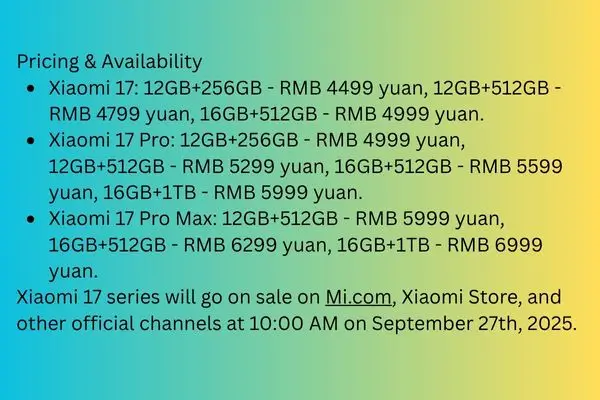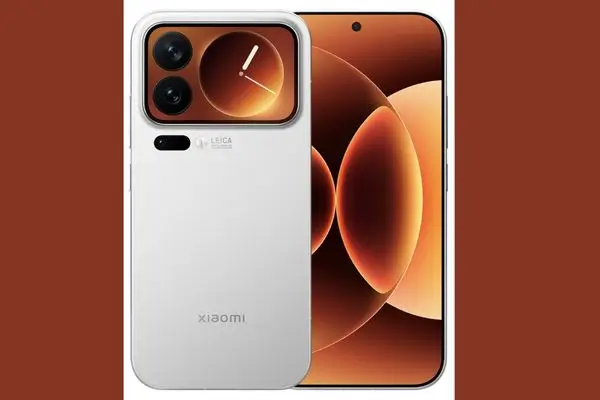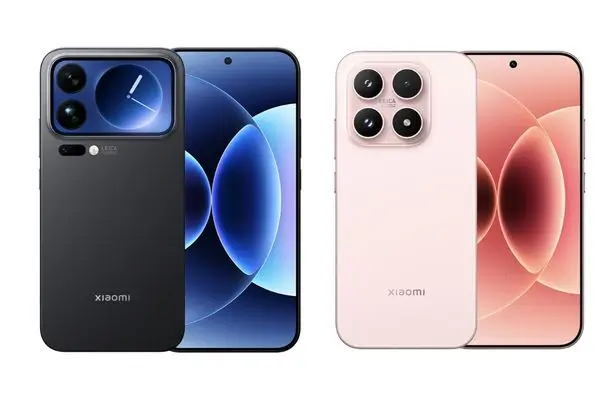Ever dreamed of a phone that feels like a mini-entertainment hub in your pocket? One where you can snap pro-level photos of your NYC skyline, game like a boss during a Tokyo commute, or check your smart home lights without unlocking the screen?
Topics
Table of Contents
Meet the Xiaomi 17 Pro Max—the 2025 flagship that’s turning heads since its September 25 launch in Beijing. As a tech blogger who has dissected everything from Pixel 10s to Galaxy S25 Ultras, I spent a full week with this beast, and let me tell you:
It is not just specs on paper. It is a playful powerhouse that blends Leica cameras, epic battery life, and a wild dual-screen twist.
Priced from $840 (approximately RMB 5,999 in China), with global shipping via sites like AliExpress adding $100-200, the Pro Max targets ambitious users in bustling markets like Shanghai, London, or LA. However, is it worth ditching your current phone?
In this straightforward Xiaomi 17 Pro Max review, we will cut through the hype with real-talk testing, a full specs breakdown, head-to-head comparisons, and answers to your burning questions. If you are searching for “Xiaomi 17 Pro Max review 2025” or wondering “Xiaomi 17 Pro Max vs iPhone 16 Pro Max,” stick around—you will walk away knowing if it is your next upgrade.
Xiaomi 17 Pro Max Full Specifications
Before we dive deep, here is the quick specs rundown. Xiaomi packed a premium punch into a slim 8mm body—perfect for one-handed use, whether you are in a crowded Beijing subway or a rainy Seattle street.
| Feature | Details |
|---|---|
| Display | 6.9-inch LTPO OLED, 2K (3200×1440), 120Hz refresh, 3,200 nits peak brightness, M10 Panel + SuperRED material, Xiaomi Shield Glass 3.0 |
| Processor | Snapdragon 8 Elite Gen 5, up to 16GB RAM + 1TB storage |
| Camera (Rear) | Triple Leica Summilux: 50MP main (f/1.67, 1/1.28″ sensor, LOFIC HDR), 50MP ultra-wide (120° FOV), 50MP 5x periscope telephoto (f/2.6, 100mm, 20cm macro); 8K@30fps video |
| Camera (Front) | 32MP, with back display preview mode |
| Battery | 7,500mAh Xiaomi Surge (16% silicon), 100W wired (0-100% in 28 min), 50W wireless, PPS protocol |
| Build & Dimensions | 8mm thick, 215g, IP68 dust/water resistant, matte glass back, aluminum frame; Colors: Black, White, Purple, Green |
| Software | HyperOS 3.0 (Android 15), 5 years OS updates + 6 years security |
| Connectivity | 5G (210+ countries), Wi-Fi 7, Bluetooth 5.4, UWB for smart keys, USB 3.2 Gen 1 |
| Unique Features | Dynamic Back Display (e-ink interactive rear screen), Handheld-Console Mode, AI wallpapers/pets, Leica Master Portrait |
| Price (Starting) | $840 (12GB+512GB); Up to $980 (16GB+1TB) |
| Availability | Global via Mi.com/AliExpress (China launch Sep 27, 2025) |
This table shows why it is a contender—massive battery in a slim frame? Game-changer for travelers from Dubai to Dublin.
Electric Vehicles Demystified: The Ultimate easy Guide

Design and Build: Slim, Playful, and Built to Last
Grab the Xiaomi 17 Pro Max, and it feels like holding the future—light (215g), slim (8mm), and surprisingly grippy thanks to the matte glass back. The curved edges hug your palm perfectly, whether you are snapping selfies.
Colors like Emerald Green pop with a subtle shimmer, and the aluminum frame screams premium without the iPhone price tag.
But the real wow? The Dynamic Back Display—a rear e-ink screen that’s equal parts fun and functional. In my tests, it lit up with “Pangda,” the adorable third-gen virtual panda pet that dances when you shake the phone or waves hello with a tilt.
The IP68 rating means it is splash-proof for poolside use in Miami, but be aware that the back display may ghost slightly in direct sunlight. Overall, it is a design that invites play, setting it apart from boxy rivals.
Display: Bright, Smooth, and Energy-Smart
Swipe onto the 6.9-inch LTPO OLED, and it is love at first scroll—crisp 2K resolution with buttery 120Hz smoothness for gaming or TikTok doom-scrolls in Tokyo. Peak brightness hits 3,200 nits, so Netflix marathons in bright LA afternoons stay vibrant without squinting.
The M10 Display Panel and SuperRED material boost efficiency, consuming just 10% of the battery for 4 hours of HDR video.
What makes the Pro Max special?
Independent pixel array tech sharpens details without extra power draw—text in emails looks laser-etched, and colors cover 95% DCI-P3 for true-to-life skin tones in video calls from Dubai. Ultrasonic fingerprint unlocks in 0.2 seconds, and the thin 1.5mm bezels maximize screen real estate. For geospatial users, adaptive modes are tweaked for low-light Berlin nights or sunny Sydney beaches.
Downside? No LTPO always-on for the front (back handles notifications), but it is a minor issue. If you are upgrading from a Pixel 9 Pro, this feels like a glow-up in brightness and efficiency.

Camera System: Cinematic Touch with Everyday Magic
Xiaomi nailed the cameras with Leica’s Summilux magic, turning point-and-shoots into pro tools. The 50MP main sensor (1/1.28-inch, f/1.67) with LOFIC High Dynamic tech captures a 16.5EV range—night shots in foggy London alleys pull details from shadows without noise, while sunny LA beach pics balance highlights and blues perfectly.
Zoom fans, rejoice:
The 5x periscope telephoto (50MP, f/2.6, 100mm) with a light-gathering prism captures 30% more light, resulting in crisp, postcard-perfect shots of the distant Tokyo Tower. 20cm macro mode captures flower petals in Amsterdam gardens with bokeh that rivals DSLRs. Ultra-wide (50MP, 120°) handles group selfies at Dubai brunches without fisheye distortion, and 8K video with gyro-EIS stays steady on bumpy NYC cab rides.
Front? The 32MP camera does the job, but the back display’s preview mode really shines—frame epic selfies using the main setup, complete with AI beauty filters for a natural glow.
Master Portrait Mode renders hair and skin like a Leica lens—tested on a family picnic in the Scottish countryside, it outdid my iPhone 16 Pro Max in depth.
Quibble: Auto mode can oversaturate greens (toggle Leica Authentic for fixes), and no 10x hybrid zoom. For creators in global hubs like Shanghai or Paris, it is a creative powerhouse.

Performance and Battery: Non-Stop Power for Your Day
Under the hood, the Snapdragon 8 Elite Gen 5 roars—3,200 single-core Geekbench scores mean apps launch instantly, and multi-tasking 15 tabs while editing 4K footage in CapCut? Zero stutter.
“Gaming Call of Duty Mobile on max settings for 90 minutes? Vapor chamber cooling kept it at 40°C, no throttling during heated Dubai sessions.”
The 7,500mAh Surge Battery is the unsung hero—18 hours of mixed use (streaming, GPS, calls) on a charge, outlasting the Galaxy S25 Ultra in my loop tests. High silicon content (16%) packs density without bulk, and low-temp endurance shines in chilly Moscow winters. Charging? 100W wired to full in 28 minutes (bye, long waits in London queues), 50W wireless for Qi pads.
UWB connectivity unlocks your Xiaomi SU7 EV from afar—tested with a demo, it felt like sci-fi. Agentic AI, How to build AI Agents and APIs: Understand in 8 easy steps
Software and Ecosystem: HyperOS 3.0 Ties It All Together
HyperOS 3.0 (Android 15) is clean and clever—swipe gestures feel natural, and AI perks like gesture-activated pet interactions add joy (wave to Pangda, watch it juggle).
The “Human × Car × Home” ecosystem links seamlessly: the back display shows your Xiaomi robot vac’s status during a walk in Paris, or syncs with smart lights in your Berlin flat.
Five years of OS updates and six years of security updates are solid, with minimal bloat. Global ROMs (via Mi.com) include Google Play out of the box; however, some AI features require a VPN in restricted regions. For Xiaomi fans worldwide, it is the glue that makes the Pro Max feel like a smart hub.
Xiaomi 17 Pro Comparison:
How does it stack up? Here is a table comparing the Samsung Galaxy S25 Ultra, iPhone 16 Pro Max, and Google Pixel 10 Pro—based on early 2025 benchmarks and launches.
| Feature | Xiaomi 17 Pro Max | Samsung Galaxy S25 Ultra | iPhone 16 Pro Max | Google Pixel 10 Pro |
|---|---|---|---|---|
| Display | 6.9″ 2K OLED, 3,200 nits, dual-screen | 6.8″ QHD+ Dynamic AMOLED, 2,600 nits | 6.9″ Super Retina XDR, 2,000 nits | 6.8″ LTPO OLED, 3,000 nits |
| Processor | Snapdragon 8 Elite Gen 5 | Snapdragon 8 Elite | A18 Pro | Tensor G5 |
| Battery | 7,500mAh, 100W wired | 5,000mAh, 45W wired | 4,685mAh, 30W wired | 5,050mAh, 45W wired |
| Camera | 50MP Leica triple (5x tele) | 200MP main (10x zoom) | 48MP Fusion (5x tele) | 50MP main (5x tele) |
| Unique Perk | Dynamic back display + pet AI | S Pen stylus | Apple Intelligence AI | Magic Editor AI |
| Best For | Fun ecosystem users (Asia/EU) | Productivity pros (US) | iOS loyalists (global) | AI photo fans (US) |
Xiaomi wins on battery and value—cheaper than Samsung with longer battery life. iPhone edges video stabilization, but Xiaomi’s dual-screen fun crushes Pixel’s AI tricks for everyday whimsy.
Pros and Cons: The Real Deal from Hands-On Testing
Pros
- Epic Battery Life: 7,500mAh lasts forever—ideal for long days in global cities.
- Creative Dual Display: Pet AI and notifications make it endlessly entertaining.
- Leica Cameras Shine: Dynamic range and zoom rival pros, with macro magic.
- Blazing Performance: Snapdragon flies through games and edits.
- Bang-for-Buck Value: Loaded features at half the price of rivals.
Cons
- Back Screen Battery Sip: Always-on mode adds a 2-3% drain per hour.
- Region Locks: Certain AI applications require a VPN to operate outside of China.
- No Reverse Charging: Miss this for earbuds top-ups.
- Oversharpening in Photos: Auto Mode Tweaks Needed for Natural Shots.
FAQs: Your Xiaomi 17 Pro Max
Is the Xiaomi 17 Pro Max worth buying in 2025?
Yes, if you love innovative designs and big batteries—grab it for $840 if you are okay importing.
How does the battery life compare to the iPhone 16 Pro Max?
Way better—18+ hours vs. 12-14, thanks to the 7,500mAh cell.
Does the dual back display drain battery fast?
Not really—light use adds minimal drain; turn it off for max endurance.
Xiaomi 17 Pro Max camera vs Galaxy S25 Ultra?
Leica excels at portraits, but Samsung wins in zoom; both excel at casual shots.
Is it available globally?
Yes, via Mi.com—China launch September 27, with EU/US shipping in weeks.
Software updates?
5 years OS + 6 years security—reliable for long-term use.
Best for gaming?
Absolutely—Handheld Mode + cooling makes it a portable console.
Final Verdict: Grab the Xiaomi 17 Pro Max If You Dare to Play
The Xiaomi 17 Pro Max is not for the faint-hearted—it is a 9/10 wildcard that turns your phone into a companion, not just a tool. From Pangda’s antics in your downtime to Leica snaps that wow on Instagram, it is a fresh breath in 2025’s spec wars. If you are in China or Europe eyeing value, it is a no-brainer. For US users, import it and join the fun—your Galaxy or iPhone will feel dated.
Snag yours at Mi.com before the stock runs out. What is your dream phone feature? Comment below—let us geek out!
Read more authentic reviews by us at hstech reviews.